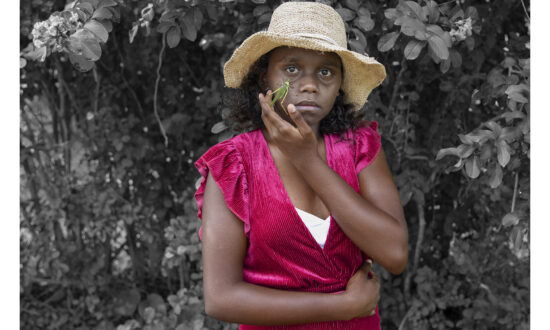A national search for a “lost” Clarice Beckett painting, titled The butterfly catcher, has been underway and last week it surfaced in a private collection.
Since its February opening, The present moment exhibition has generated a groundswell of excitement and critical acclaim across the nation. Last week art critic John McDonald stated that, “this exhibition is so phenomenal I saw it three days in a row … If this show were being staged at Tate Modern or the Museum of Modern Art, Beckett would be hailed as a figure of world renown”.
It is difficult to comprehend this superstar trajectory, given that for 35 years, 2000 of Beckett’s paintings were at risk of oblivion and that to this day, the artist remains shrouded in mystery. Her status is associated with a heartbreaking story of neglect and rediscovery that is now scorched into our nation’s psyche. It is a story recently regarded as “one of the great disasters of Australian art history”.
Driven by a deeply spiritual impulse, and working mostly outdoors in Melbourne in the 1920s and 1930s, Clarice viewed the painting process as an act of self-renewal, creating works that “ache with feeling”. Like a visionary mystic, she worked beyond worldly success, and her paintings were widely misunderstood in her lifetime.
Her absolute emotional immersion in the process of capturing the world through shifting veils of light ultimately led to her demise. Having been soaked to the marrow while painting in a storm, Beckett later developed double pneumonia, her heart having been weakened by childhood rheumatic fever and frail from the grief of the loss of her mother in 1934. She died aged 48, on July 6 in 1935, in a Sandringham nursing home and was buried at the Cheltenham cemetery.
After her death her light was extinguished, like the flame of a candle. The majority of Beckett’s most experimental paintings, executed between 1930 and 1934, were burnt by her father and the approximately 2000 paintings that remained in her estate were stored in an open-sided shed at the family’s property, near Benalla in rural Victoria. The paintings remained untouched at this site for more than 30 years until a chance encounter saw them rediscovered by Dr Rosalind Hollinrake in around 1970.
Exposed to the elements and the ravages of possums, just over 370 works were salvaged from this tomb-like space by Hollinrake and lovingly returned to their former glory, to again be shared with Australian audiences. Around 1600 of the canvases were beyond repair. More than 30 other paintings that survived in another private collection, were destroyed in a house fire in 1944, in country Victoria. Tragedy, disaster and the uncanny appear to shadow her legacy.
The late addition of The butterfly catcher sheds light on her distinctive mastery in alluding to the fleeting nature of the human experience
Incomprehensibly, no letters, diaries and almost no records of Clarice’s private life remain that may provide insight into her aims and inspiration. The paintings that have survived become for audiences precious daily chronicles of a life that seems as ethereal as the paintings themselves. Nearly 90 years after the artist’s death, around 600 extant works have been documented, but many in private collections remain unlocated.
It is here that the butterfly returns to this story.
As the exhibition curator, the staging of this exhibition has provided an important opportunity to locate many of Clarice Beckett’s “lost” paintings, especially those that have personal associations and that provide us with a rare window into her life. Once in private hands, paintings customarily become increasingly difficult to track.
Late last year, I put out a call via an article in The Australian to locate two intimate portraits by Beckett, The butterfly catcher and Resting place: one of her young niece and one of an intriguing unavailable love interest. In response to the call, the owner of The butterfly catcher recently contacted the gallery and agreed to loan the painting to its exhibition, as well as one other, previously unknown treasure, Bright morning.
The butterfly catcher shows the artist’s niece, Patricia, in the garden of the Beckett family home, and next month the subject’s daughter is excited to have her first chance in decades to see this image of her mother. It is an enchanting family subject that, for me, poetically symbolised the quest to capture information about the elusive Clarice and her own transient qualities. Now the exhibition is open, the butterfly enigmatically points to the artist’s transformative critical reception as a mystical artist of international importance.
The present moment is structured to chart the course of a single day, to illustrate the artist’s interest in duration and her belief in the unity of life. The late addition of The butterfly catcher sheds light on her distinctive mastery in alluding to the fleeting nature of the human experience.
As the curator, I recommend catching the Clarice Beckett exhibition before it slips through your fingers.
Clarice Beckett: The present moment is at the Art Gallery of SA until May 16. This week’s First Fridays after-hours event at the AGSA will include guided tours of the exhibition, as well as poetry readings, live music and a painting demonstration. Start at the Gallery, the monthly event for kids and families, is also on this Sunday.
Tracey Lock is curator of Australian paintings and sculpture at the AGSA.
Support local arts journalism
Your support will help us continue the important work of InReview in publishing free professional journalism that celebrates, interrogates and amplifies arts and culture in South Australia.
Donate Here




